Car-Free City Expansion: Issues, Impacts, and Skills Analysis Report
VerifiedAdded on 2023/06/17
|14
|3098
|110
Report
AI Summary
This report explores the multifaceted impacts of transitioning to car-free cities, focusing on health, economic, environmental, and social dimensions. It examines how reducing reliance on automobiles can improve public health through increased physical activity and reduced pollution-related illnesses. Economically, the report discusses opportunities for green space development, tourism, and reduced tax burdens. The analysis extends to the tourism, hospitality, and event industries, highlighting potential growth through enhanced transportation options. Environmentally, the report addresses reduced soil sealing and promotion of sustainable transportation. Socially, the report considers the creation of inclusive spaces and the revitalization of communities. The report acknowledges challenges associated with stakeholder alignment and ensuring equitable access for all citizens, recommending a balanced approach that prioritizes essential services and fosters public awareness.

Academic and Professional
Skills
Skills
Paraphrase This Document
Need a fresh take? Get an instant paraphrase of this document with our AI Paraphraser
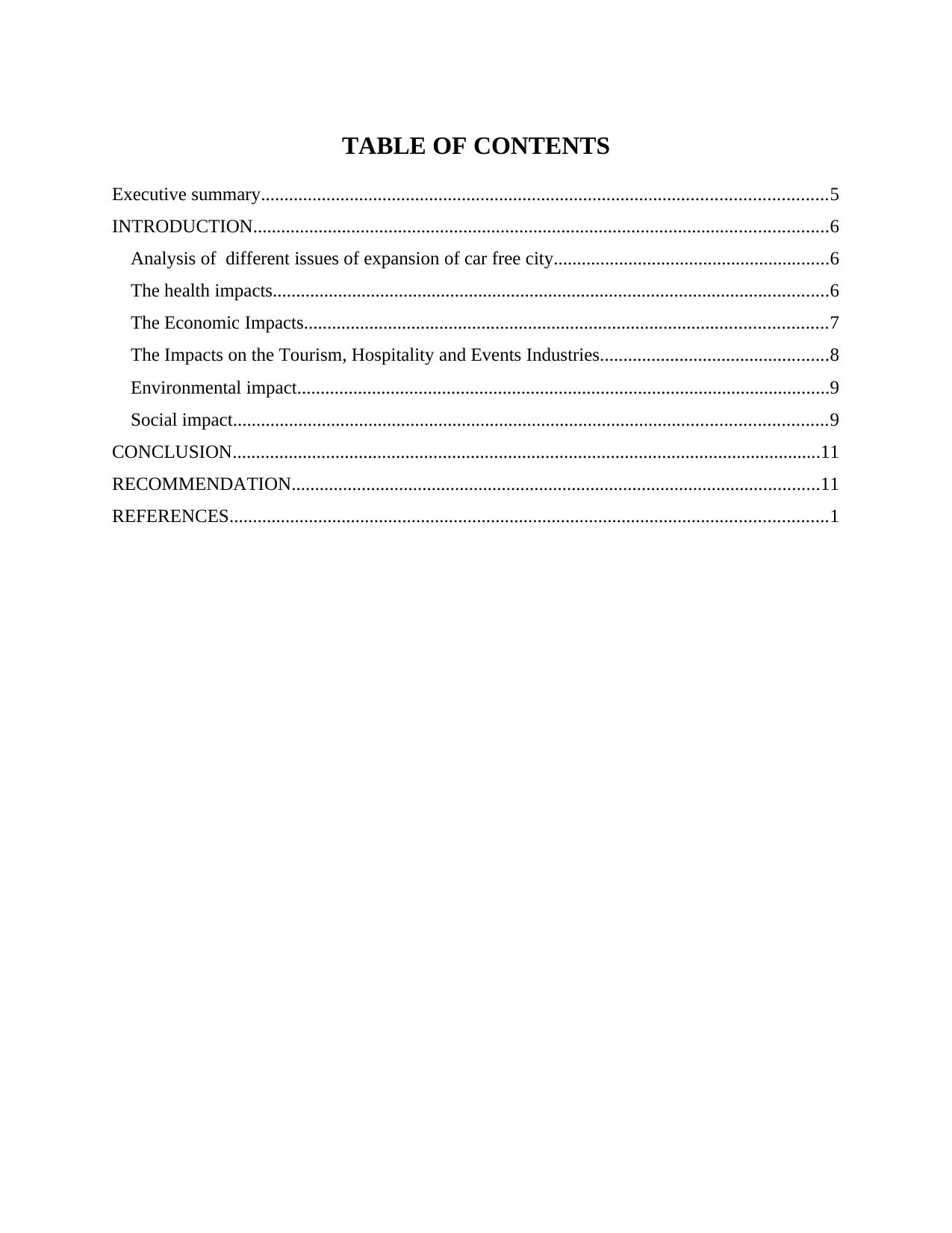
TABLE OF CONTENTS
Executive summary.........................................................................................................................5
INTRODUCTION...........................................................................................................................6
Analysis of different issues of expansion of car free city...........................................................6
The health impacts.......................................................................................................................6
The Economic Impacts................................................................................................................7
The Impacts on the Tourism, Hospitality and Events Industries.................................................8
Environmental impact..................................................................................................................9
Social impact...............................................................................................................................9
CONCLUSION..............................................................................................................................11
RECOMMENDATION.................................................................................................................11
REFERENCES................................................................................................................................1
Executive summary.........................................................................................................................5
INTRODUCTION...........................................................................................................................6
Analysis of different issues of expansion of car free city...........................................................6
The health impacts.......................................................................................................................6
The Economic Impacts................................................................................................................7
The Impacts on the Tourism, Hospitality and Events Industries.................................................8
Environmental impact..................................................................................................................9
Social impact...............................................................................................................................9
CONCLUSION..............................................................................................................................11
RECOMMENDATION.................................................................................................................11
REFERENCES................................................................................................................................1

⊘ This is a preview!⊘
Do you want full access?
Subscribe today to unlock all pages.

Trusted by 1+ million students worldwide

Paraphrase This Document
Need a fresh take? Get an instant paraphrase of this document with our AI Paraphraser
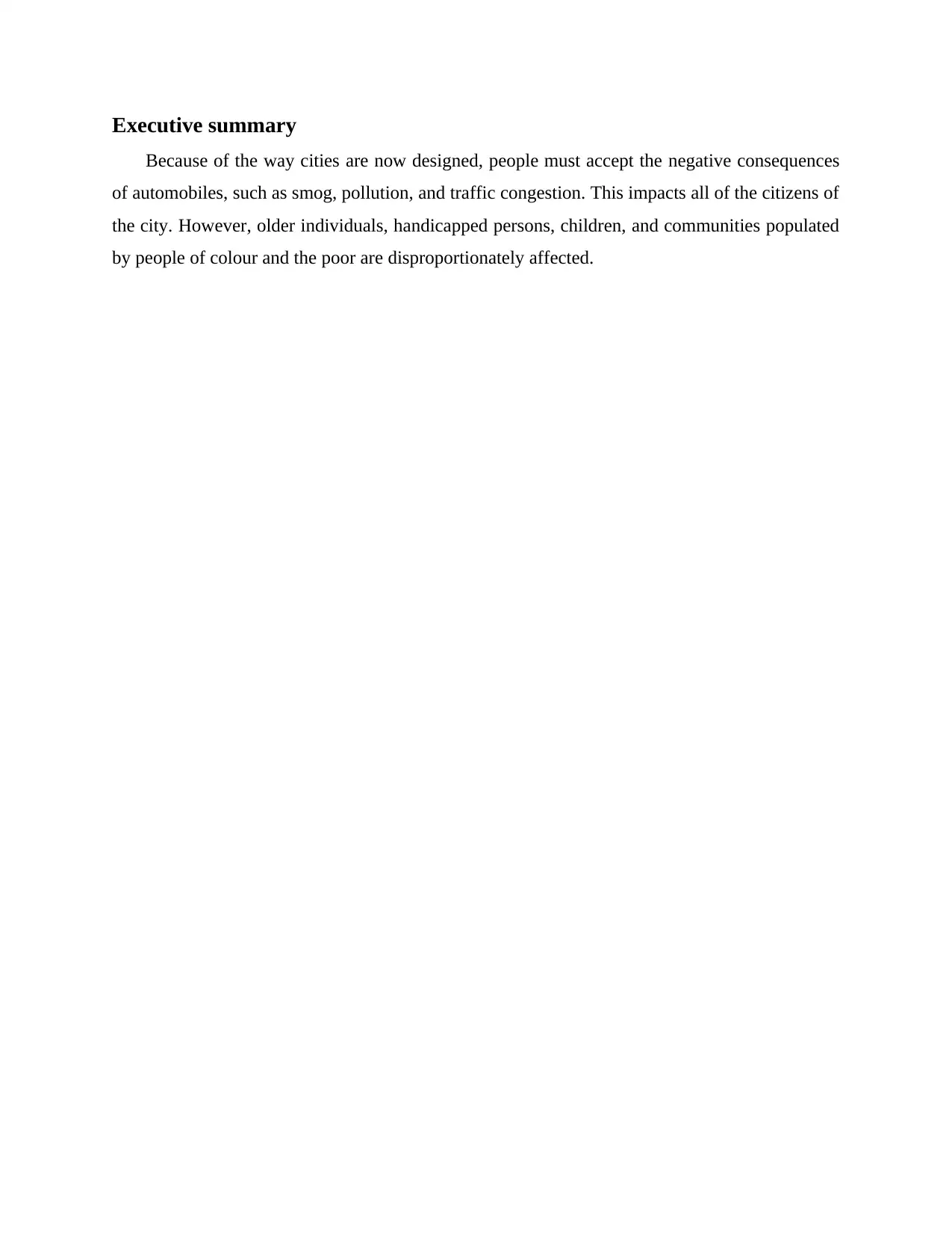
Executive summary
Because of the way cities are now designed, people must accept the negative consequences
of automobiles, such as smog, pollution, and traffic congestion. This impacts all of the citizens of
the city. However, older individuals, handicapped persons, children, and communities populated
by people of colour and the poor are disproportionately affected.
Because of the way cities are now designed, people must accept the negative consequences
of automobiles, such as smog, pollution, and traffic congestion. This impacts all of the citizens of
the city. However, older individuals, handicapped persons, children, and communities populated
by people of colour and the poor are disproportionately affected.
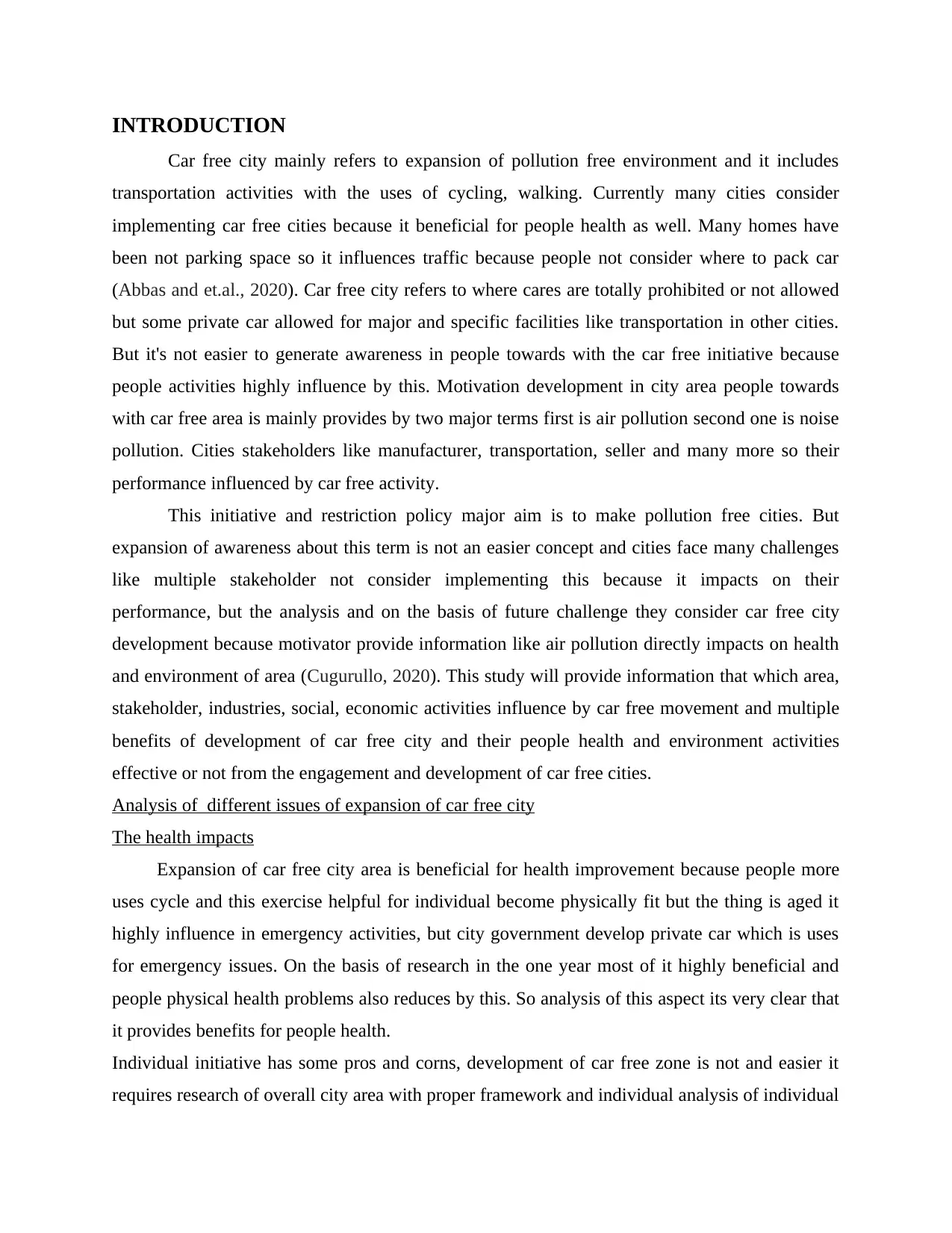
INTRODUCTION
Car free city mainly refers to expansion of pollution free environment and it includes
transportation activities with the uses of cycling, walking. Currently many cities consider
implementing car free cities because it beneficial for people health as well. Many homes have
been not parking space so it influences traffic because people not consider where to pack car
(Abbas and et.al., 2020). Car free city refers to where cares are totally prohibited or not allowed
but some private car allowed for major and specific facilities like transportation in other cities.
But it's not easier to generate awareness in people towards with the car free initiative because
people activities highly influence by this. Motivation development in city area people towards
with car free area is mainly provides by two major terms first is air pollution second one is noise
pollution. Cities stakeholders like manufacturer, transportation, seller and many more so their
performance influenced by car free activity.
This initiative and restriction policy major aim is to make pollution free cities. But
expansion of awareness about this term is not an easier concept and cities face many challenges
like multiple stakeholder not consider implementing this because it impacts on their
performance, but the analysis and on the basis of future challenge they consider car free city
development because motivator provide information like air pollution directly impacts on health
and environment of area (Cugurullo, 2020). This study will provide information that which area,
stakeholder, industries, social, economic activities influence by car free movement and multiple
benefits of development of car free city and their people health and environment activities
effective or not from the engagement and development of car free cities.
Analysis of different issues of expansion of car free city
The health impacts
Expansion of car free city area is beneficial for health improvement because people more
uses cycle and this exercise helpful for individual become physically fit but the thing is aged it
highly influence in emergency activities, but city government develop private car which is uses
for emergency issues. On the basis of research in the one year most of it highly beneficial and
people physical health problems also reduces by this. So analysis of this aspect its very clear that
it provides benefits for people health.
Individual initiative has some pros and corns, development of car free zone is not and easier it
requires research of overall city area with proper framework and individual analysis of individual
Car free city mainly refers to expansion of pollution free environment and it includes
transportation activities with the uses of cycling, walking. Currently many cities consider
implementing car free cities because it beneficial for people health as well. Many homes have
been not parking space so it influences traffic because people not consider where to pack car
(Abbas and et.al., 2020). Car free city refers to where cares are totally prohibited or not allowed
but some private car allowed for major and specific facilities like transportation in other cities.
But it's not easier to generate awareness in people towards with the car free initiative because
people activities highly influence by this. Motivation development in city area people towards
with car free area is mainly provides by two major terms first is air pollution second one is noise
pollution. Cities stakeholders like manufacturer, transportation, seller and many more so their
performance influenced by car free activity.
This initiative and restriction policy major aim is to make pollution free cities. But
expansion of awareness about this term is not an easier concept and cities face many challenges
like multiple stakeholder not consider implementing this because it impacts on their
performance, but the analysis and on the basis of future challenge they consider car free city
development because motivator provide information like air pollution directly impacts on health
and environment of area (Cugurullo, 2020). This study will provide information that which area,
stakeholder, industries, social, economic activities influence by car free movement and multiple
benefits of development of car free city and their people health and environment activities
effective or not from the engagement and development of car free cities.
Analysis of different issues of expansion of car free city
The health impacts
Expansion of car free city area is beneficial for health improvement because people more
uses cycle and this exercise helpful for individual become physically fit but the thing is aged it
highly influence in emergency activities, but city government develop private car which is uses
for emergency issues. On the basis of research in the one year most of it highly beneficial and
people physical health problems also reduces by this. So analysis of this aspect its very clear that
it provides benefits for people health.
Individual initiative has some pros and corns, development of car free zone is not and easier it
requires research of overall city area with proper framework and individual analysis of individual
⊘ This is a preview!⊘
Do you want full access?
Subscribe today to unlock all pages.

Trusted by 1+ million students worldwide
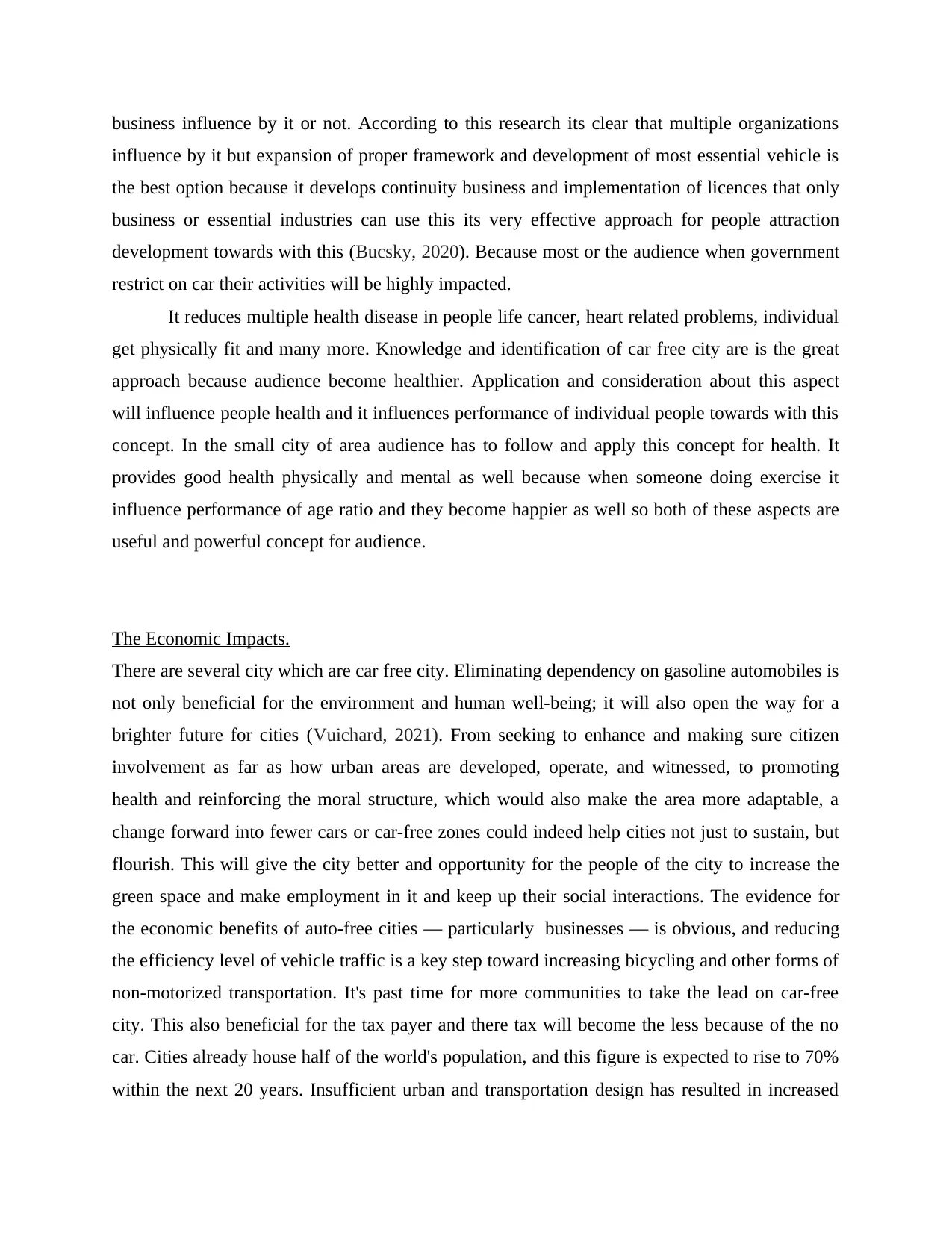
business influence by it or not. According to this research its clear that multiple organizations
influence by it but expansion of proper framework and development of most essential vehicle is
the best option because it develops continuity business and implementation of licences that only
business or essential industries can use this its very effective approach for people attraction
development towards with this (Bucsky, 2020). Because most or the audience when government
restrict on car their activities will be highly impacted.
It reduces multiple health disease in people life cancer, heart related problems, individual
get physically fit and many more. Knowledge and identification of car free city are is the great
approach because audience become healthier. Application and consideration about this aspect
will influence people health and it influences performance of individual people towards with this
concept. In the small city of area audience has to follow and apply this concept for health. It
provides good health physically and mental as well because when someone doing exercise it
influence performance of age ratio and they become happier as well so both of these aspects are
useful and powerful concept for audience.
The Economic Impacts.
There are several city which are car free city. Eliminating dependency on gasoline automobiles is
not only beneficial for the environment and human well-being; it will also open the way for a
brighter future for cities (Vuichard, 2021). From seeking to enhance and making sure citizen
involvement as far as how urban areas are developed, operate, and witnessed, to promoting
health and reinforcing the moral structure, which would also make the area more adaptable, a
change forward into fewer cars or car-free zones could indeed help cities not just to sustain, but
flourish. This will give the city better and opportunity for the people of the city to increase the
green space and make employment in it and keep up their social interactions. The evidence for
the economic benefits of auto-free cities — particularly businesses — is obvious, and reducing
the efficiency level of vehicle traffic is a key step toward increasing bicycling and other forms of
non-motorized transportation. It's past time for more communities to take the lead on car-free
city. This also beneficial for the tax payer and there tax will become the less because of the no
car. Cities already house half of the world's population, and this figure is expected to rise to 70%
within the next 20 years. Insufficient urban and transportation design has resulted in increased
influence by it but expansion of proper framework and development of most essential vehicle is
the best option because it develops continuity business and implementation of licences that only
business or essential industries can use this its very effective approach for people attraction
development towards with this (Bucsky, 2020). Because most or the audience when government
restrict on car their activities will be highly impacted.
It reduces multiple health disease in people life cancer, heart related problems, individual
get physically fit and many more. Knowledge and identification of car free city are is the great
approach because audience become healthier. Application and consideration about this aspect
will influence people health and it influences performance of individual people towards with this
concept. In the small city of area audience has to follow and apply this concept for health. It
provides good health physically and mental as well because when someone doing exercise it
influence performance of age ratio and they become happier as well so both of these aspects are
useful and powerful concept for audience.
The Economic Impacts.
There are several city which are car free city. Eliminating dependency on gasoline automobiles is
not only beneficial for the environment and human well-being; it will also open the way for a
brighter future for cities (Vuichard, 2021). From seeking to enhance and making sure citizen
involvement as far as how urban areas are developed, operate, and witnessed, to promoting
health and reinforcing the moral structure, which would also make the area more adaptable, a
change forward into fewer cars or car-free zones could indeed help cities not just to sustain, but
flourish. This will give the city better and opportunity for the people of the city to increase the
green space and make employment in it and keep up their social interactions. The evidence for
the economic benefits of auto-free cities — particularly businesses — is obvious, and reducing
the efficiency level of vehicle traffic is a key step toward increasing bicycling and other forms of
non-motorized transportation. It's past time for more communities to take the lead on car-free
city. This also beneficial for the tax payer and there tax will become the less because of the no
car. Cities already house half of the world's population, and this figure is expected to rise to 70%
within the next 20 years. Insufficient urban and transportation design has resulted in increased
Paraphrase This Document
Need a fresh take? Get an instant paraphrase of this document with our AI Paraphraser
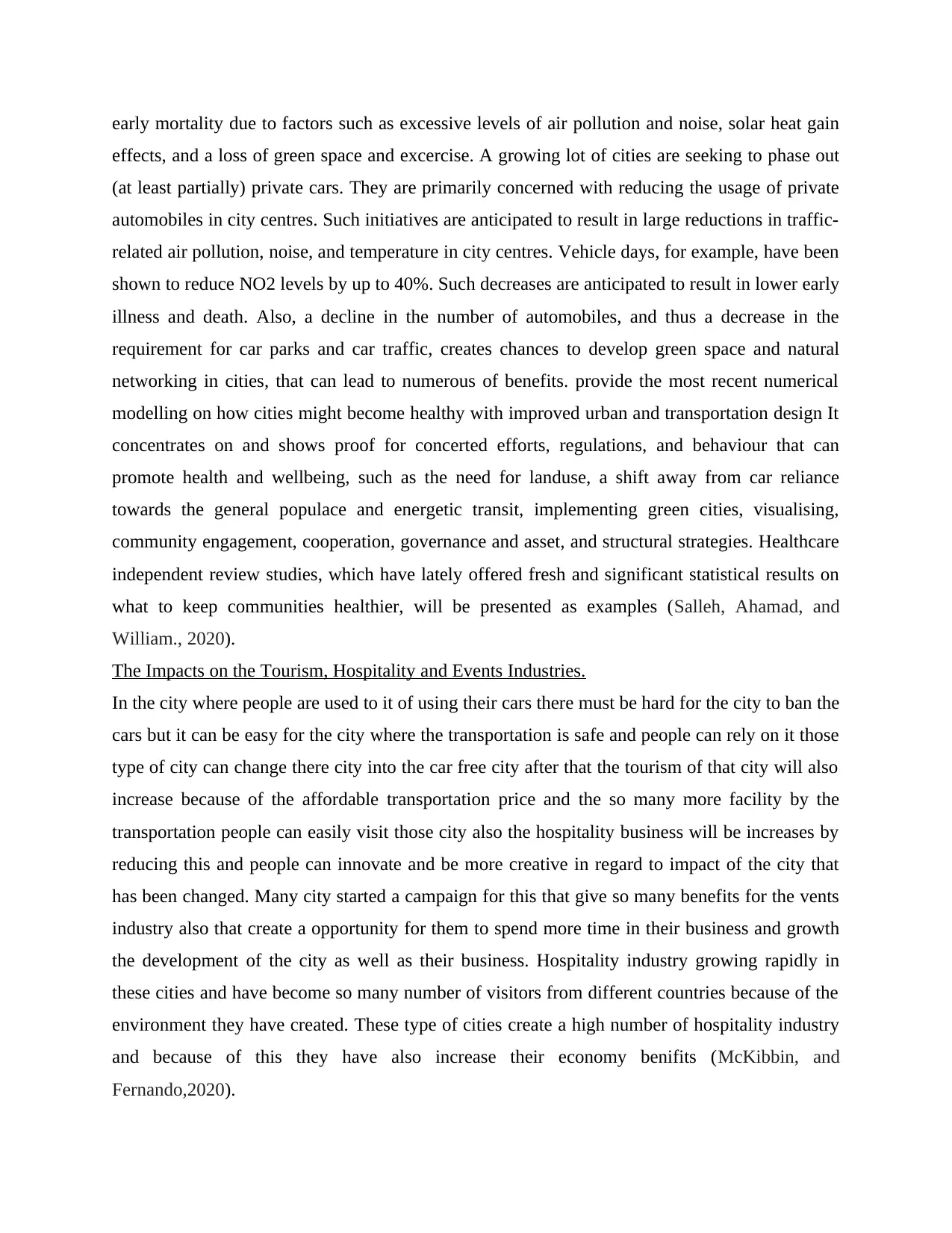
early mortality due to factors such as excessive levels of air pollution and noise, solar heat gain
effects, and a loss of green space and excercise. A growing lot of cities are seeking to phase out
(at least partially) private cars. They are primarily concerned with reducing the usage of private
automobiles in city centres. Such initiatives are anticipated to result in large reductions in traffic-
related air pollution, noise, and temperature in city centres. Vehicle days, for example, have been
shown to reduce NO2 levels by up to 40%. Such decreases are anticipated to result in lower early
illness and death. Also, a decline in the number of automobiles, and thus a decrease in the
requirement for car parks and car traffic, creates chances to develop green space and natural
networking in cities, that can lead to numerous of benefits. provide the most recent numerical
modelling on how cities might become healthy with improved urban and transportation design It
concentrates on and shows proof for concerted efforts, regulations, and behaviour that can
promote health and wellbeing, such as the need for landuse, a shift away from car reliance
towards the general populace and energetic transit, implementing green cities, visualising,
community engagement, cooperation, governance and asset, and structural strategies. Healthcare
independent review studies, which have lately offered fresh and significant statistical results on
what to keep communities healthier, will be presented as examples (Salleh, Ahamad, and
William., 2020).
The Impacts on the Tourism, Hospitality and Events Industries.
In the city where people are used to it of using their cars there must be hard for the city to ban the
cars but it can be easy for the city where the transportation is safe and people can rely on it those
type of city can change there city into the car free city after that the tourism of that city will also
increase because of the affordable transportation price and the so many more facility by the
transportation people can easily visit those city also the hospitality business will be increases by
reducing this and people can innovate and be more creative in regard to impact of the city that
has been changed. Many city started a campaign for this that give so many benefits for the vents
industry also that create a opportunity for them to spend more time in their business and growth
the development of the city as well as their business. Hospitality industry growing rapidly in
these cities and have become so many number of visitors from different countries because of the
environment they have created. These type of cities create a high number of hospitality industry
and because of this they have also increase their economy benifits (McKibbin, and
Fernando,2020).
effects, and a loss of green space and excercise. A growing lot of cities are seeking to phase out
(at least partially) private cars. They are primarily concerned with reducing the usage of private
automobiles in city centres. Such initiatives are anticipated to result in large reductions in traffic-
related air pollution, noise, and temperature in city centres. Vehicle days, for example, have been
shown to reduce NO2 levels by up to 40%. Such decreases are anticipated to result in lower early
illness and death. Also, a decline in the number of automobiles, and thus a decrease in the
requirement for car parks and car traffic, creates chances to develop green space and natural
networking in cities, that can lead to numerous of benefits. provide the most recent numerical
modelling on how cities might become healthy with improved urban and transportation design It
concentrates on and shows proof for concerted efforts, regulations, and behaviour that can
promote health and wellbeing, such as the need for landuse, a shift away from car reliance
towards the general populace and energetic transit, implementing green cities, visualising,
community engagement, cooperation, governance and asset, and structural strategies. Healthcare
independent review studies, which have lately offered fresh and significant statistical results on
what to keep communities healthier, will be presented as examples (Salleh, Ahamad, and
William., 2020).
The Impacts on the Tourism, Hospitality and Events Industries.
In the city where people are used to it of using their cars there must be hard for the city to ban the
cars but it can be easy for the city where the transportation is safe and people can rely on it those
type of city can change there city into the car free city after that the tourism of that city will also
increase because of the affordable transportation price and the so many more facility by the
transportation people can easily visit those city also the hospitality business will be increases by
reducing this and people can innovate and be more creative in regard to impact of the city that
has been changed. Many city started a campaign for this that give so many benefits for the vents
industry also that create a opportunity for them to spend more time in their business and growth
the development of the city as well as their business. Hospitality industry growing rapidly in
these cities and have become so many number of visitors from different countries because of the
environment they have created. These type of cities create a high number of hospitality industry
and because of this they have also increase their economy benifits (McKibbin, and
Fernando,2020).
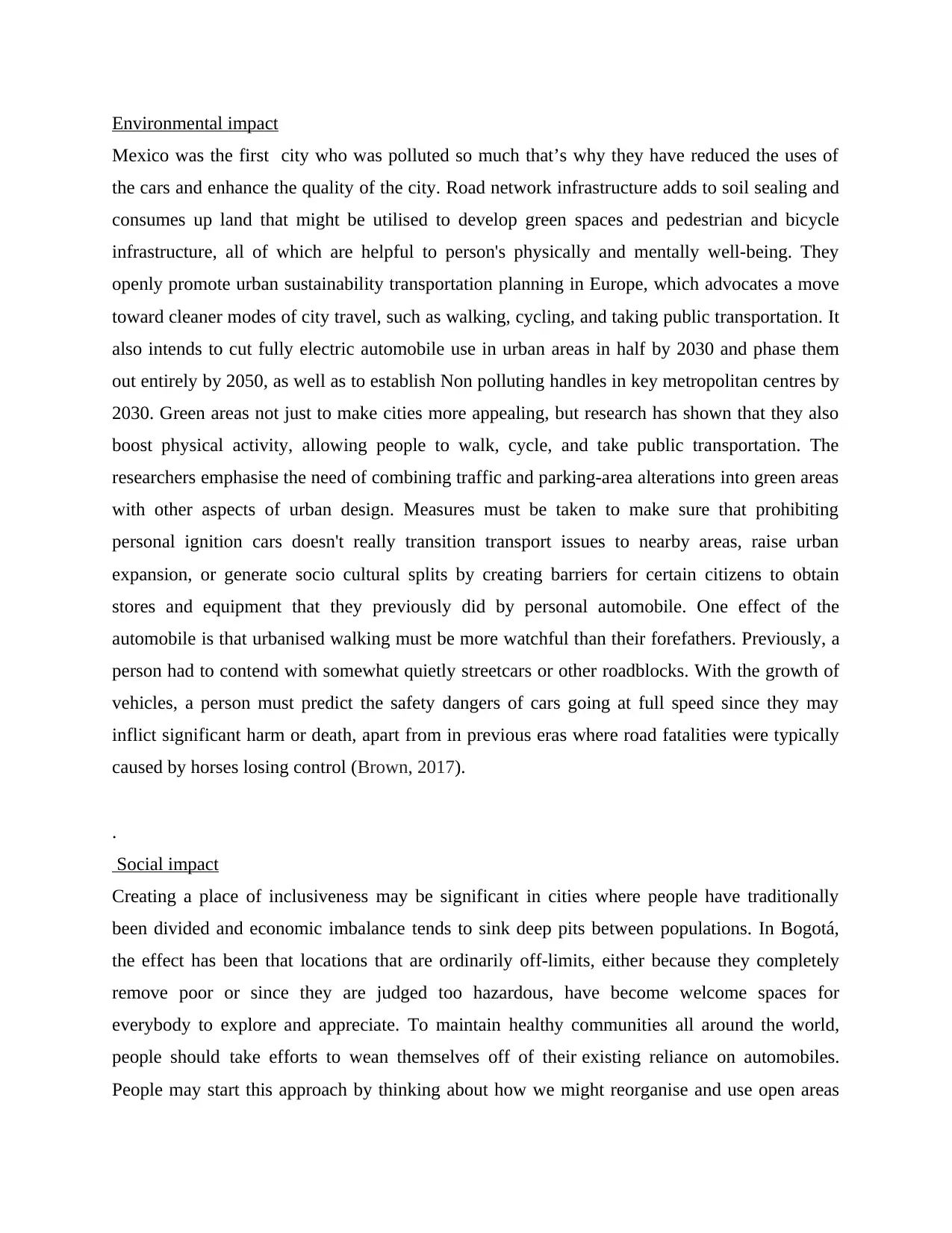
Environmental impact
Mexico was the first city who was polluted so much that’s why they have reduced the uses of
the cars and enhance the quality of the city. Road network infrastructure adds to soil sealing and
consumes up land that might be utilised to develop green spaces and pedestrian and bicycle
infrastructure, all of which are helpful to person's physically and mentally well-being. They
openly promote urban sustainability transportation planning in Europe, which advocates a move
toward cleaner modes of city travel, such as walking, cycling, and taking public transportation. It
also intends to cut fully electric automobile use in urban areas in half by 2030 and phase them
out entirely by 2050, as well as to establish Non polluting handles in key metropolitan centres by
2030. Green areas not just to make cities more appealing, but research has shown that they also
boost physical activity, allowing people to walk, cycle, and take public transportation. The
researchers emphasise the need of combining traffic and parking-area alterations into green areas
with other aspects of urban design. Measures must be taken to make sure that prohibiting
personal ignition cars doesn't really transition transport issues to nearby areas, raise urban
expansion, or generate socio cultural splits by creating barriers for certain citizens to obtain
stores and equipment that they previously did by personal automobile. One effect of the
automobile is that urbanised walking must be more watchful than their forefathers. Previously, a
person had to contend with somewhat quietly streetcars or other roadblocks. With the growth of
vehicles, a person must predict the safety dangers of cars going at full speed since they may
inflict significant harm or death, apart from in previous eras where road fatalities were typically
caused by horses losing control (Brown, 2017).
.
Social impact
Creating a place of inclusiveness may be significant in cities where people have traditionally
been divided and economic imbalance tends to sink deep pits between populations. In Bogotá,
the effect has been that locations that are ordinarily off-limits, either because they completely
remove poor or since they are judged too hazardous, have become welcome spaces for
everybody to explore and appreciate. To maintain healthy communities all around the world,
people should take efforts to wean themselves off of their existing reliance on automobiles.
People may start this approach by thinking about how we might reorganise and use open areas
Mexico was the first city who was polluted so much that’s why they have reduced the uses of
the cars and enhance the quality of the city. Road network infrastructure adds to soil sealing and
consumes up land that might be utilised to develop green spaces and pedestrian and bicycle
infrastructure, all of which are helpful to person's physically and mentally well-being. They
openly promote urban sustainability transportation planning in Europe, which advocates a move
toward cleaner modes of city travel, such as walking, cycling, and taking public transportation. It
also intends to cut fully electric automobile use in urban areas in half by 2030 and phase them
out entirely by 2050, as well as to establish Non polluting handles in key metropolitan centres by
2030. Green areas not just to make cities more appealing, but research has shown that they also
boost physical activity, allowing people to walk, cycle, and take public transportation. The
researchers emphasise the need of combining traffic and parking-area alterations into green areas
with other aspects of urban design. Measures must be taken to make sure that prohibiting
personal ignition cars doesn't really transition transport issues to nearby areas, raise urban
expansion, or generate socio cultural splits by creating barriers for certain citizens to obtain
stores and equipment that they previously did by personal automobile. One effect of the
automobile is that urbanised walking must be more watchful than their forefathers. Previously, a
person had to contend with somewhat quietly streetcars or other roadblocks. With the growth of
vehicles, a person must predict the safety dangers of cars going at full speed since they may
inflict significant harm or death, apart from in previous eras where road fatalities were typically
caused by horses losing control (Brown, 2017).
.
Social impact
Creating a place of inclusiveness may be significant in cities where people have traditionally
been divided and economic imbalance tends to sink deep pits between populations. In Bogotá,
the effect has been that locations that are ordinarily off-limits, either because they completely
remove poor or since they are judged too hazardous, have become welcome spaces for
everybody to explore and appreciate. To maintain healthy communities all around the world,
people should take efforts to wean themselves off of their existing reliance on automobiles.
People may start this approach by thinking about how we might reorganise and use open areas
⊘ This is a preview!⊘
Do you want full access?
Subscribe today to unlock all pages.

Trusted by 1+ million students worldwide
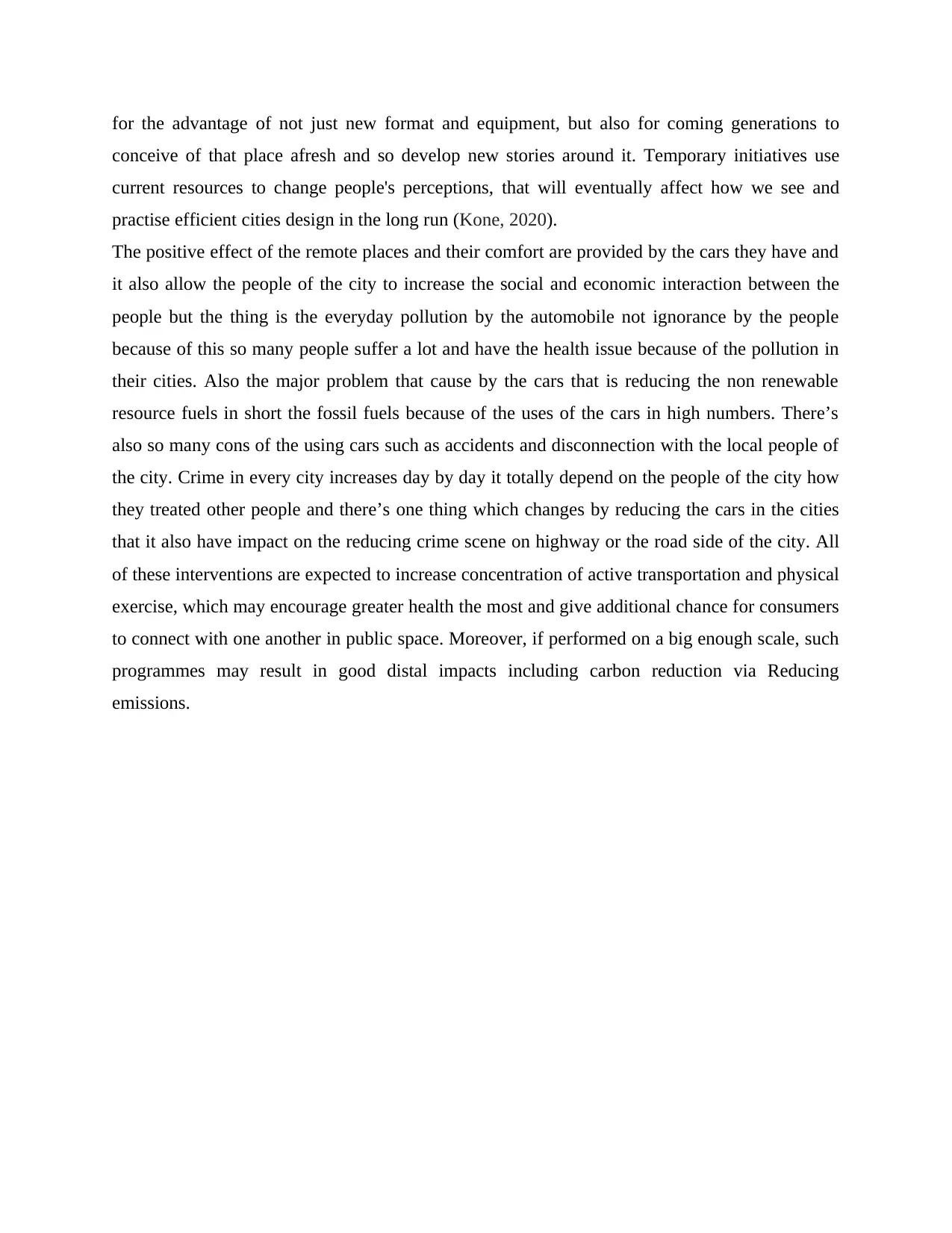
for the advantage of not just new format and equipment, but also for coming generations to
conceive of that place afresh and so develop new stories around it. Temporary initiatives use
current resources to change people's perceptions, that will eventually affect how we see and
practise efficient cities design in the long run (Kone, 2020).
The positive effect of the remote places and their comfort are provided by the cars they have and
it also allow the people of the city to increase the social and economic interaction between the
people but the thing is the everyday pollution by the automobile not ignorance by the people
because of this so many people suffer a lot and have the health issue because of the pollution in
their cities. Also the major problem that cause by the cars that is reducing the non renewable
resource fuels in short the fossil fuels because of the uses of the cars in high numbers. There’s
also so many cons of the using cars such as accidents and disconnection with the local people of
the city. Crime in every city increases day by day it totally depend on the people of the city how
they treated other people and there’s one thing which changes by reducing the cars in the cities
that it also have impact on the reducing crime scene on highway or the road side of the city. All
of these interventions are expected to increase concentration of active transportation and physical
exercise, which may encourage greater health the most and give additional chance for consumers
to connect with one another in public space. Moreover, if performed on a big enough scale, such
programmes may result in good distal impacts including carbon reduction via Reducing
emissions.
conceive of that place afresh and so develop new stories around it. Temporary initiatives use
current resources to change people's perceptions, that will eventually affect how we see and
practise efficient cities design in the long run (Kone, 2020).
The positive effect of the remote places and their comfort are provided by the cars they have and
it also allow the people of the city to increase the social and economic interaction between the
people but the thing is the everyday pollution by the automobile not ignorance by the people
because of this so many people suffer a lot and have the health issue because of the pollution in
their cities. Also the major problem that cause by the cars that is reducing the non renewable
resource fuels in short the fossil fuels because of the uses of the cars in high numbers. There’s
also so many cons of the using cars such as accidents and disconnection with the local people of
the city. Crime in every city increases day by day it totally depend on the people of the city how
they treated other people and there’s one thing which changes by reducing the cars in the cities
that it also have impact on the reducing crime scene on highway or the road side of the city. All
of these interventions are expected to increase concentration of active transportation and physical
exercise, which may encourage greater health the most and give additional chance for consumers
to connect with one another in public space. Moreover, if performed on a big enough scale, such
programmes may result in good distal impacts including carbon reduction via Reducing
emissions.
Paraphrase This Document
Need a fresh take? Get an instant paraphrase of this document with our AI Paraphraser
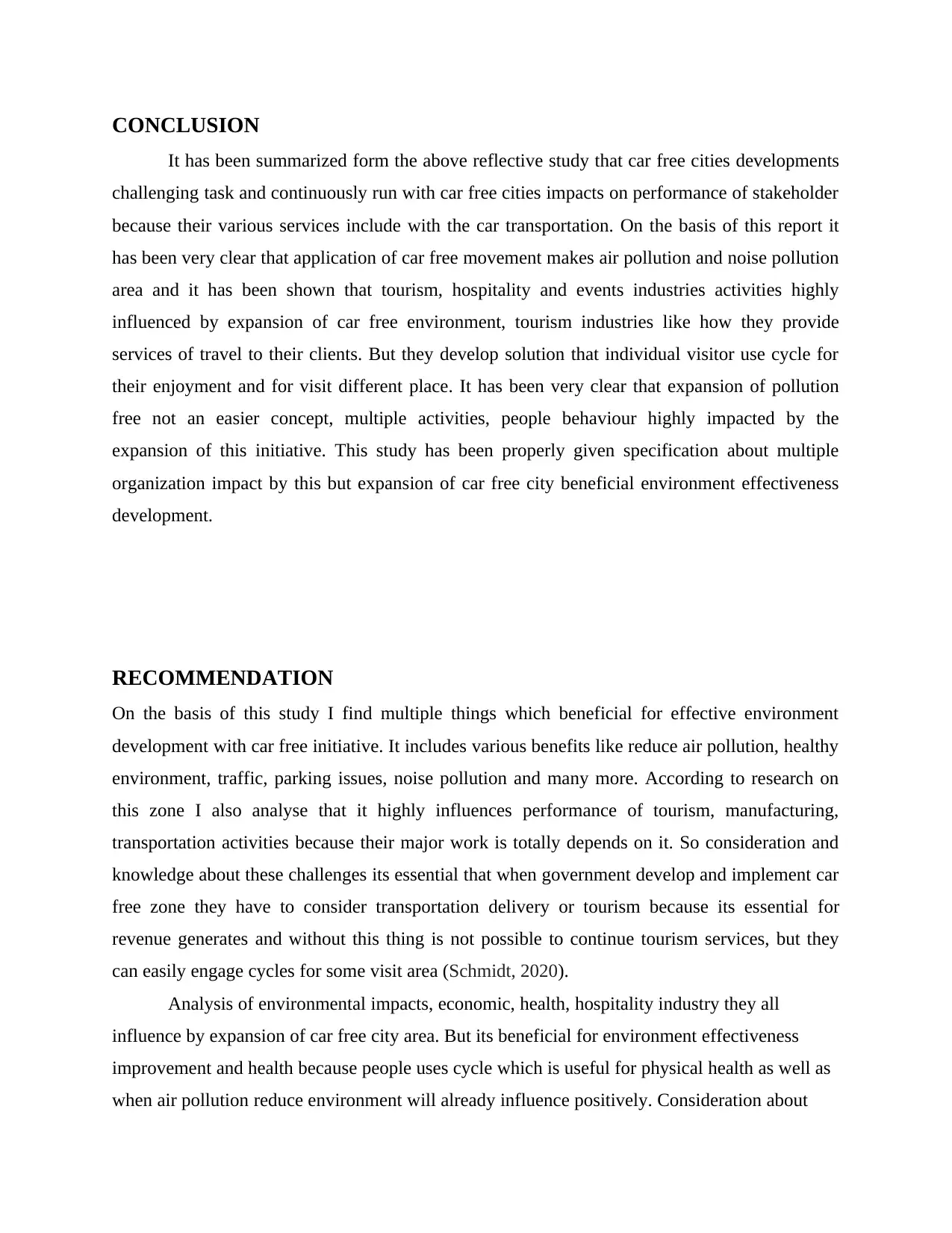
CONCLUSION
It has been summarized form the above reflective study that car free cities developments
challenging task and continuously run with car free cities impacts on performance of stakeholder
because their various services include with the car transportation. On the basis of this report it
has been very clear that application of car free movement makes air pollution and noise pollution
area and it has been shown that tourism, hospitality and events industries activities highly
influenced by expansion of car free environment, tourism industries like how they provide
services of travel to their clients. But they develop solution that individual visitor use cycle for
their enjoyment and for visit different place. It has been very clear that expansion of pollution
free not an easier concept, multiple activities, people behaviour highly impacted by the
expansion of this initiative. This study has been properly given specification about multiple
organization impact by this but expansion of car free city beneficial environment effectiveness
development.
RECOMMENDATION
On the basis of this study I find multiple things which beneficial for effective environment
development with car free initiative. It includes various benefits like reduce air pollution, healthy
environment, traffic, parking issues, noise pollution and many more. According to research on
this zone I also analyse that it highly influences performance of tourism, manufacturing,
transportation activities because their major work is totally depends on it. So consideration and
knowledge about these challenges its essential that when government develop and implement car
free zone they have to consider transportation delivery or tourism because its essential for
revenue generates and without this thing is not possible to continue tourism services, but they
can easily engage cycles for some visit area (Schmidt, 2020).
Analysis of environmental impacts, economic, health, hospitality industry they all
influence by expansion of car free city area. But its beneficial for environment effectiveness
improvement and health because people uses cycle which is useful for physical health as well as
when air pollution reduce environment will already influence positively. Consideration about
It has been summarized form the above reflective study that car free cities developments
challenging task and continuously run with car free cities impacts on performance of stakeholder
because their various services include with the car transportation. On the basis of this report it
has been very clear that application of car free movement makes air pollution and noise pollution
area and it has been shown that tourism, hospitality and events industries activities highly
influenced by expansion of car free environment, tourism industries like how they provide
services of travel to their clients. But they develop solution that individual visitor use cycle for
their enjoyment and for visit different place. It has been very clear that expansion of pollution
free not an easier concept, multiple activities, people behaviour highly impacted by the
expansion of this initiative. This study has been properly given specification about multiple
organization impact by this but expansion of car free city beneficial environment effectiveness
development.
RECOMMENDATION
On the basis of this study I find multiple things which beneficial for effective environment
development with car free initiative. It includes various benefits like reduce air pollution, healthy
environment, traffic, parking issues, noise pollution and many more. According to research on
this zone I also analyse that it highly influences performance of tourism, manufacturing,
transportation activities because their major work is totally depends on it. So consideration and
knowledge about these challenges its essential that when government develop and implement car
free zone they have to consider transportation delivery or tourism because its essential for
revenue generates and without this thing is not possible to continue tourism services, but they
can easily engage cycles for some visit area (Schmidt, 2020).
Analysis of environmental impacts, economic, health, hospitality industry they all
influence by expansion of car free city area. But its beneficial for environment effectiveness
improvement and health because people uses cycle which is useful for physical health as well as
when air pollution reduce environment will already influence positively. Consideration about
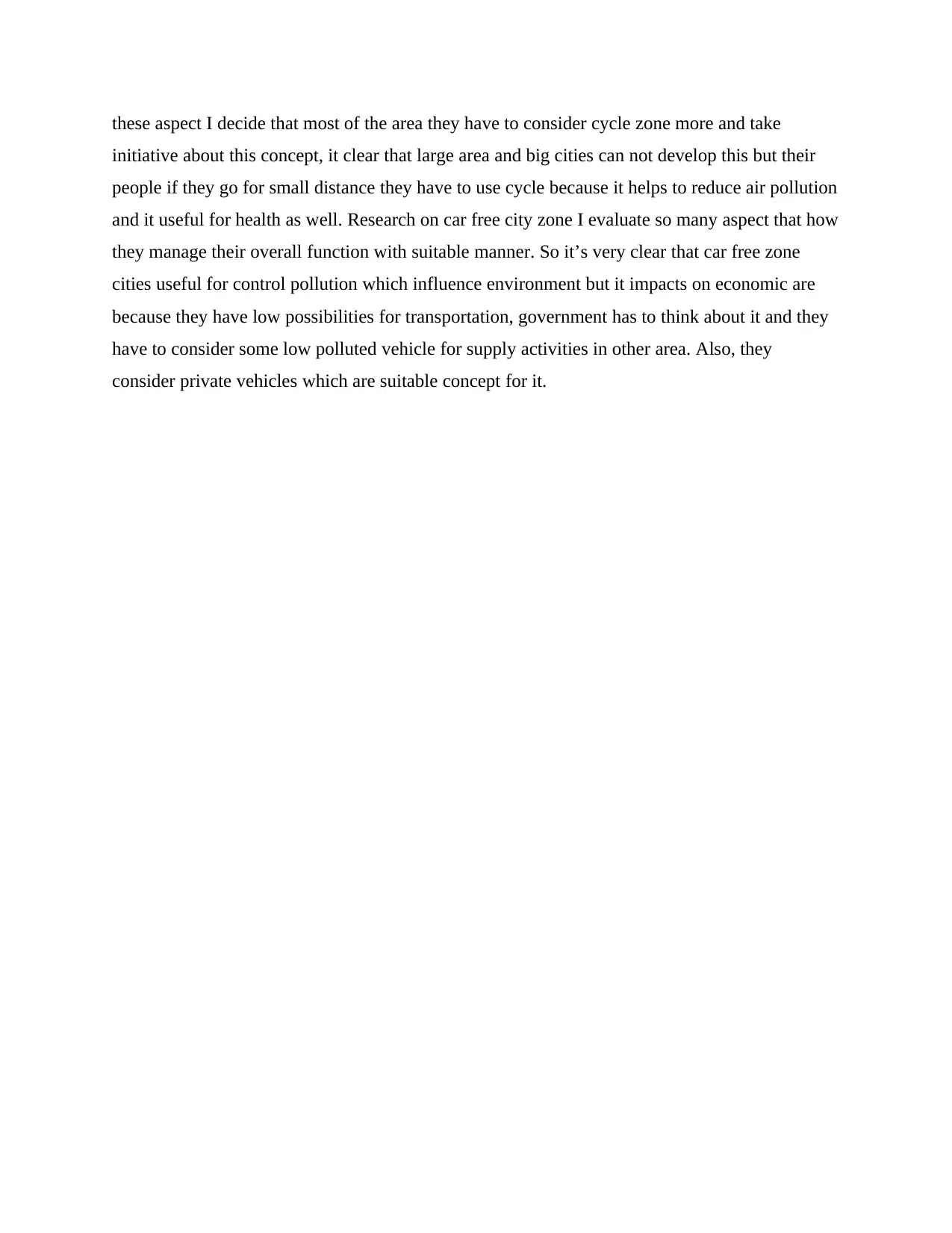
these aspect I decide that most of the area they have to consider cycle zone more and take
initiative about this concept, it clear that large area and big cities can not develop this but their
people if they go for small distance they have to use cycle because it helps to reduce air pollution
and it useful for health as well. Research on car free city zone I evaluate so many aspect that how
they manage their overall function with suitable manner. So it’s very clear that car free zone
cities useful for control pollution which influence environment but it impacts on economic are
because they have low possibilities for transportation, government has to think about it and they
have to consider some low polluted vehicle for supply activities in other area. Also, they
consider private vehicles which are suitable concept for it.
initiative about this concept, it clear that large area and big cities can not develop this but their
people if they go for small distance they have to use cycle because it helps to reduce air pollution
and it useful for health as well. Research on car free city zone I evaluate so many aspect that how
they manage their overall function with suitable manner. So it’s very clear that car free zone
cities useful for control pollution which influence environment but it impacts on economic are
because they have low possibilities for transportation, government has to think about it and they
have to consider some low polluted vehicle for supply activities in other area. Also, they
consider private vehicles which are suitable concept for it.
⊘ This is a preview!⊘
Do you want full access?
Subscribe today to unlock all pages.

Trusted by 1+ million students worldwide
1 out of 14
Related Documents
Your All-in-One AI-Powered Toolkit for Academic Success.
+13062052269
info@desklib.com
Available 24*7 on WhatsApp / Email
![[object Object]](/_next/static/media/star-bottom.7253800d.svg)
Unlock your academic potential
Copyright © 2020–2025 A2Z Services. All Rights Reserved. Developed and managed by ZUCOL.


